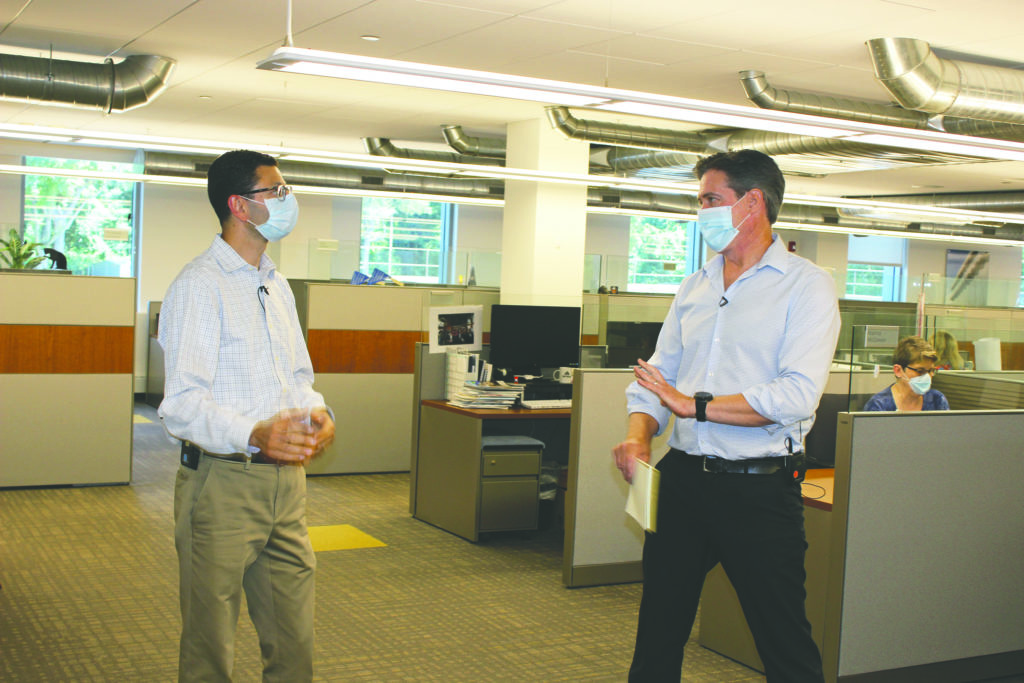
As Long Island enters Phase 4, many non-essential workers are returning to the office for the first time in months. For some remote workers who have been trying their best to call their living room their office while the TV blared and their children screamed in the background, this is a welcomed change in the scheduled programming. For others, it can be nerve-racking to consider sitting in a cubical after the pandemic’s devastation swept the state.
In this new normal, a regular 9-to-5 workday will not look the same as it did prior to the outbreak. But there are a number of safety protocols in place to keep employers and employees healthy and productive once they’ve returned to the office.
During a Northwell Health Facebook Live session held on July 2, the hospital’s Senior Vice President and Chief People Officer Joseph Moscola spoke with Senior Multimedia Producer Rob Hoell to discuss the CDC’s guidelines for safely returning to work. As part of Northwell’s outreach, its staff educates employers on proper safety measures, everything from on-site visits to evaluate an office’s cleaning solutions or desk setup. The hospital even offers the two main types of testing for COVID: the nasal swab that tests for the virus and antibody testing, which indicates a person’s degree of immunity from the virus.
“Northwell saw one most amount of COVID patients in the health system during the surge, which gives us a unique opportunity to be able to speak with other employees,” Moscola said.
The following are highlights from the CDC’s recommendations as well as advice from Moscola, for both employers and employees:
What To Ask Your Employer:
“Understand the precautions your company is taking to prevent the spread of COVID-19,” Moscola said. Each industry is different, and may be subject to different guidelines, however, the CDC is clear on certain universal rules. Employers can develop fact sheets to easily distribute this information with employees.
- Where is the hand sanitizer located in the office?
- Are cubicles at least six-feet part?
- How is the workplace being cleaned?
- How often is the workplace being cleaned? Everything from the desks, to the doorknobs and the bathrooms.
- How is the air filtration system being updated or cleaned?
Employers Should Encourage Flexible Schedules
Roughly 10,000 of Northwell Health’s staff of 72,000 continues to work remotely during the pandemic. Moscola suggests that employers should call employees working from home to maintain relationships. Northwell for example, surveys its remote workforce regularly and hosts zoom meetings and town halls to listen to its staff and establish trust. The CDC recommends the following:
- Use technology to promote social distancing (e.g., telework and virtual meetings)
- Consider policies that encourage flexible sick leave and alternative work schedules.
- Cancel group events.
- Employers Should Encourage Sick Employees to Stay Home
- Employees who have symptoms should notify their supervisor and stay home.
- Employees who are well but who have a sick family member at home with COVID-19 should notify their supervisor and follow CDC recommended precautions.
Identify Where and How Workers Might Be Exposed to COVID-19 at Work
- Conduct a thorough hazard assessment to determine if workplace hazards are present, or are likely to be present, and determine what type of controls or PPE are needed for specific job duties.
- Encourage workers to wear a cloth face covering at work if the hazard assessment has determined that they do not require PPE, such as a respirator or medical face mask for protection.
- Consider Conducting Daily In-Person or Virtual Health Checks
- Conduct symptoms and temperature screenings before employees enter the building.
- If implementing in-person health checks, conduct them safely and respectfully.
- Employers may use social distancing, barrier or partition controls, or personal protective equipment if possible.
- Follow guidance from the Equal Employment Opportunity Commission regarding the confidentiality of medical records from health checks.
Take Action if an Employee is Suspected or Confirmed to Have COVID-19 Infection
- Wait 24 hours before cleaning and disinfecting to minimize the potential for other employees being exposed to respiratory droplets. If waiting 24 hours is not feasible, wait as long as possible.
- During this waiting period, open outside doors and windows to increase air circulation in these areas.


















